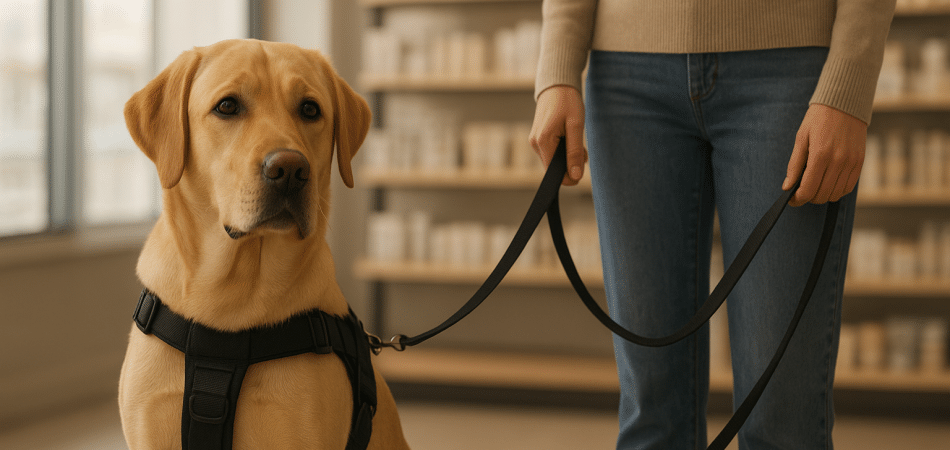






On the surface, it’s a legal question. A question about access, permission, maybe even power. But underneath it? It’s a question about belonging. Whether the life you’ve built with your dog—this deeply bonded, highly trained, mutually protective life—has a place beyond the threshold of your home.
Because while your protection dog may be highly disciplined, steady, and better behaved than most pets (and frankly, some people), that doesn’t automatically open every public door.
The law doesn’t move for devotion. It moves for definitions.
And the law says that unless your dog is trained to perform specific tasks for a person with a disability, they aren’t covered under the ADA.
Meaning? Most stores don’t have to allow personal protection dogs. And that means you’re at the mercy of store policies, manager discretion, or the silent calculation playing out behind a cashier’s eyes. Some will welcome a well-behaved protection dog. Others won’t. And you’ll need to respect that.
Now, before we get too tangled in red tape and regulation, let’s understand the legalities, the etiquette, and the practical realities.
But first, what makes a personal protection dog, and how does that differ from a service animal or an emotional support animal?
It’s easy to lump them all together, but these categories have very different definitions—and legal rights.
 Trained to defend their handler or family, these dogs are skilled in identifying threats, deterring intruders, and, in some cases, engaging on command. Their loyalty is fierce, their presence grounding.
Trained to defend their handler or family, these dogs are skilled in identifying threats, deterring intruders, and, in some cases, engaging on command. Their loyalty is fierce, their presence grounding.
But their training is geared towards safety, not supporting a medical diagnosis. That difference changes everything.
Legally recognized under the Americans with Disabilities Act (ADA), service dogs are trained to perform specific tasks for people with disabilities.
That might include guiding a visually impaired person, detecting oncoming seizures, retrieving medication when mobility is limited, or calming a panic attack midair. Because they’re medically necessary, they’re allowed just about anywhere—airports, cafes, retail shops, you name it.
ESAs provide comfort and emotional stability for individuals with mental health conditions, like anxiety or depression. But unlike service dogs, they don’t perform trained tasks. Their mere presence is therapeutic—and while that’s incredibly valuable, it doesn’t come with full legal protections.
They aren’t recognized under the ADA, which means no guaranteed access to public places. However, they do have some limited protections under housing laws and (in some cases) air travel policies.
That said, many airlines and landlords now require documentation, and policies are tightening.
This distinction matters. So, even if your personal protection dog is better trained than half the service dogs out there (and sometimes, that’s true), it still doesn’t change how the law sees them.
Short answer? Sometimes.
Long answer? It depends on where you are, what kind of store it is, and the store owner’s policy.
Here’s the breakdown:
Under the ADA, only service dogs get guaranteed access. A personal protection dog—even one that’s impeccably trained—doesn’t qualify unless it performs a task for a person with a disability.
Some states have broader definitions or additional protections for different types of working dogs, but these rarely extend to personal protection dogs. It’s important to check your local regulations to avoid unintentional violations.
Retailers, restaurants, and other businesses can allow or prohibit non-service animals. Some big-box stores may be pet-friendly. Others have strict no-animal policies. Either way, they have the legal right to say no.
Now….
Walking into public spaces with a powerful animal at your side carries a certain weight. It asks you to rise to the occasion. To carry yourself—and your dog—with a kind of quiet grace.
How does that look in practice?

Skip the tactical vests and intense body language. A low-profile, neutral appearance helps others feel at ease. A plain leash or vest sends the right message without drawing unnecessary attention.
Even if your dog is flawlessly trained off-leash, public places are non-negotiable: leash on. It reassures others and shows that you’re in control.
No pulling. No sniffing. No reacting. Your dog should be invisible until needed—blending into the environment. Because as soon as there’s even a whiff of misbehavior, the situation shifts. Store owners may start second-guessing their decision to let you in. Customers may feel unsafe. Don’t give them a reason to worry.
Tight aisles, crowds, kids darting around—these are real triggers, even for the best-trained dogs. You know your dog. You know when their body stiffens, when their alert level rises.
When your dog starts to dial in? Leave before tension builds. No debate. Just a quiet exit that preserves your reputation—and your dog’s, too.
Falsely claiming your dog is a service animal can land you in legal trouble in many states. Plus, it undermines the rights of people who depend on service dogs daily.
The world owes you nothing. That includes store owners, staff, and strangers. When the answer is no, let it be no—with dignity.
I’ve seen some people take it personally when a business turns them away with their protection dog, but often, it’s not about them. It’s about the bigger picture that businesses have to manage every day.
And when you look at it from their side, the reasons start to make sense:
If something—anything—were to go wrong, the business could be on the hook. They’re not thinking, “Your dog is dangerous.” They’re thinking, “What happens if someone gets hurt, and we’re responsible? ”Saying no can simply be their way of playing it safe.
Some people are afraid of dogs. Others may have allergies. And for many businesses, especially those in customer-facing roles, maintaining a welcoming atmosphere for all patrons is a priority.
Restaurants, grocery stores, and food prep areas are often bound by strict health regulations. In many jurisdictions, these codes prohibit animals entirely, regardless of how well they’re trained. It’s not personal; it’s policy.
To own a personal protection dog is to accept the weight that comes with it—not just the training or the responsibility, but the understanding that public access is a privilege reserved for service animals.
That means knowing the rules, respecting them, and recognizing that your dog’s capabilities don’t override someone else’s boundaries. Your dog may be calm. Well-trained. But that alone doesn’t change policy—or perception.
The goal isn’t to force access or prove a point. It’s to move through the world responsibly. To adapt when necessary. And to carry yourself—and your dog—with the kind of discipline that dissolves fear, not fuels it. That’s how you change perceptions. Contact us today to learn more!